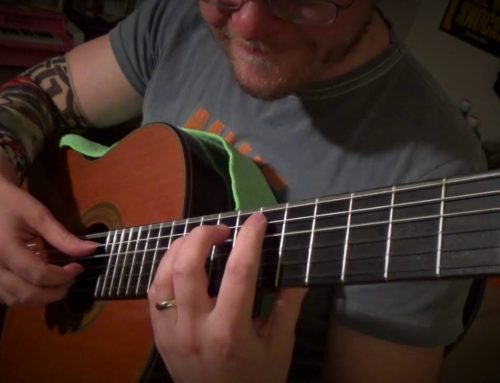‾‾‾‾‾‾‾‾‾‾‾‾‾‾‾‾‾‾‾‾‾‾‾‾‾‾‾‾‾‾‾‾‾‾‾‾‾‾‾‾‾‾‾‾‾‾‾‾‾‾‾‾‾‾‾‾‾‾‾‾‾‾‾‾
Ana Vidović’s Interpretation of Albeniz’s Asturias:
Ana Vidović plays Asturias. Her rendition of Isaac Albeniz’s Asturias is a tour de force that showcases the Croatian guitarist’s unparalleled technical prowess and profound musicality. Her interpretation is a captivating blend of fiery passion and delicate nuance, transforming the already evocative piece into a breathtaking sonic experience.
Vidović’s technical command of the guitar is simply astonishing. The rapid-fire arpeggios, intricate scales, and complex harmonies are executed with flawless precision and effortless fluidity. Her right-hand technique is particularly impressive, demonstrating an extraordinary ability to produce a wide range of colors and dynamics. Yet, despite the formidable technical challenges, Vidović never loses sight of the music’s emotional core. Her interpretation is imbued with a deep sense of poetry and drama, drawing listeners into the heart of the piece.

Learning Asturias is a formidable undertaking for any guitarist. The piece demands an exceptionally high level of technical proficiency, as well as a deep understanding of musical structure and phrasing. Many guitarists find the rapid-fire arpeggios and complex rhythmic patterns to be particularly challenging. Developing the necessary finger independence and strength to execute these passages cleanly and accurately requires dedicated practice and attention to detail.
Additionally, capturing the desired tonal quality and dynamic range can be a significant hurdle. The piece calls for a wide spectrum of sounds, from delicate pianissimo passages to powerful fortissimo outbursts. Achieving a balanced and expressive sound throughout the piece is essential to creating a compelling interpretation.
While Vidović’s performance offers invaluable insights into the piece, it’s important to remember that every guitarist’s interpretation should be a personal expression. By studying Vidović’s approach and combining it with one’s own musical sensibilities, aspiring guitarists can embark on a rewarding journey of discovery and musical growth.
* Contact us: info@siccasguitars.com
Classical guitars are our passion! We are specialized in the highest quality concert guitars as well as historic guitars from around the world. Our passion for these unique instruments and the joy to give guitarists, passionate players, and collectors the possibility to purchase their own appropriate instrument is the motivation that drives us. Another focus is to work closely with established and young, largely unknown luthiers. Together we want to develop new ideas and share experiences with our customers.
We also recorded pieces for many great composers such as Johann Sebastian Bach, Astor Piazzolla and Isaac Albeniz (Asturias). You will also find almost all the classical music composers that wrote for the classical guitar. Make sure to discover Agustin Barrios Mangoré, Manuel Maria Ponce, Heitor Villa-Lobos and many more if you don’t know their compositions already
Ana Vidovic plays Asturias (technical Challenges)
Asturias presents a myriad of technical challenges for guitarists. Let’s delve into some of the most common ones:
Right-hand Technique
- Alternate Picking: The piece heavily relies on alternate picking, demanding exceptional speed, accuracy, and consistency. Maintaining a clear and even tone while executing rapid-fire passages is crucial.
- Rest Stroke: Mastering the rest stroke is essential for producing the characteristic percussive sounds in certain sections. Achieving a balanced and controlled rest stroke can be challenging.
- Fingerstyle Arpeggios: The intricate arpeggios require precise finger placement, independence, and coordination. Developing the strength and dexterity to execute these passages cleanly is a significant hurdle.
Left-hand Technique
- Stretch Positions: The piece features several challenging stretch positions, demanding flexibility and finger strength. Achieving clean intonation while playing in these positions can be difficult.
- Shifting: Smooth and efficient shifting is crucial for maintaining musical continuity. Mastering the art of shifting without interrupting the flow of the music is essential.
- Vibrato: Applying tasteful vibrato can add depth and expressiveness to the performance. Finding the right balance of vibrato speed and intensity can be challenging.
Rhythmic Challenges
- Syncopation: The piece incorporates complex rhythmic patterns and syncopations, requiring careful attention to detail. Maintaining a steady pulse while navigating these rhythmic complexities can be demanding.
- Hemiola: Understanding and executing the hemiola sections accurately is crucial for capturing the rhythmic character of the piece.
Learn classical guitar in Dallas, Ga. click here.
‾‾‾‾‾‾‾‾‾‾‾‾‾‾‾‾‾‾‾‾‾‾‾‾‾‾‾‾‾‾‾‾‾‾‾‾‾‾‾‾‾‾‾‾‾‾‾‾‾‾‾‾‾‾‾‾‾‾‾‾‾‾‾‾
gA





3:15 ‘Bronchitias’ by Isaac Akoffdrop.
you need more likes
@@thekumarize he really does
this is hilarious
!Cojones!
😹😹😹😹😹 Lmao!
Imagine some guy trying to impress her with his guitar, then she takes it from him and plays this.
I’d string up
but can she play wonderwall tho
Then he’ll start coughing
I guess if it was Alessando Penezzi he’d be alright… https://www.youtube.com/watch?v=IU59ueizlKM
I’d take my guitar and walk the hall of shame 😐
Relax everyone…the coughing man was taken out back after the show and summarily executed.
Didnt know the performance was in China..
Go away. Emo is dead.
@@earlgrae If this was in China you wouldn’t even be able to joke around about executing people.
@@creetan9997 are you always this much of a wet blanket?
@@fakename287 Which comment of mine made you think I’m a wet blanket?
Ana Vidovic made a wonderful personal video for all of you, check it out 😍 https://www.youtube.com/watch?v=LjuIYd2DX1E
Sweet thanks, hope no music will disturbed the coughing this time
Concierto de atanjuez
🤣🤣🤣🤣
Music sent from heaven played by a true angel in SPIRIT
Anna hears nothing but HER thoughts and that’s why she is so brilliant
This girl gave me the inspiration to sell my guitar
hhhhhhhhhhhhhhhhh dude
@@PlasticSaber more like ffffffffffffffffffffffff dude
LMAOOO
Hahahaha
thanks for make smile on my face
At first glance this piece seems very hard to play.
But as you learn it, you’ll find out that yeah it really is very hard.
Sure. Just 15 years of study and training!
Not gonna lie here. They had us in the first half😂
Nope, its not hard if practiced nice and slow
@@lispuhizamustafa763 STFU
Lol!!!!!😂😂😂😂
I’ve worked with Ana Vidovic. I started in classical coughing after switching from cello aged 13. I’ve been coughing professionally now for over 30 years and have worked with some of the worlds finest audiences and on many famous recordings. In this particular work the challenge, as always, is to cough between the beats when least expected and to work with the sound engineers to choose the best part of the auditorium to achieve the correct reverberation for the genre. Believe it or not we did this in one take. Ana is great to work with, she actually prefers the Cadenza coughing fit over her work and very much leaves it up to me as the artist.
drowned.
Yes, I’m a bit of a pro myself, but my speciality is more baritone, you know, downstairs.
I had to give up playing piano accordion because of a medical issue, the problem being that people within ear shot of my playing kept attacking me, my new instrument is more organic, and indeed can at times, take the breath away.
underrated comment
I mastered coughing in my late 20’s and moved on to bigger things. I’ve been working on causing others to cough, and with the right combination of baked beans and sprouts I can have the whole auditorium choking with just one massive fart!
@@pobsdad Oh, my dear boy, you have missed the point, the contemporaneous belch and expulsion of methane is the mark of real genius.
The cough in G minor at 3:41…simply amazing.
what a st**** guy
Isn’t that why were all here ?
The timbre of the phlegm is superb
Dude i think the same , it was literally at the right time
omg noo
Why everyone is saying it’s hard to play, i just clicked on video and it started
😂😂
😂😂
haha
😂😂😂😂
🤣🤣👍
I am from Asturias (in Spain) and I have to say that this piece is very important to us and to see it performed so sweetly is something spectacular
Whats the importance of said piece? Curious
Im also form Asturias. There’s a municipality in the in Asturias that’s actually named after my last name.
Spain the guitar tree! Spain is Guitar. They culturally intertwined.
@caprice.t hm ok, but the style is very reminiscent of the south of Spain.
I have family in Gijon ! Viva Asturias !
As a heavy metal fan this piece is fantastic. I listen to it often. It has an intensity and ferocity that is missing that is missing in most music. I love it.
@@paulmcgrath6118 I am familiar with that song but had not noticed the similarities between it and this one. Thanks for pointing it out.
Yes you right
Do you possibly think that Spanish caravan was inspired by this masterpiece because they sound very similar and this one is obviously first
@@honrarkley3174 That’s correct, Spanish Caravan’s guitar was directly taken from this piece. Robbie Krieger is classically trained.
@@GG-jt8st Wow good to know
I love Spanish classics like this. This seems to me to suggest barely controlled passion, some primal feelings that are bubbling under the surface.
That’s the Spanish emotion
@jerrylouiswiththethickness6403, Total nonsense, Albéniz wasn’t gipsy, and Flamenco comes from the spanish ancestral boleros
@jerrylouiswiththethickness6403 , By the way, what nonsense about german/irish music, the irish fathers are the spanish, irish mithology.
That’s exactly what I was feeling throughout the entire piece.
I’ve lost count of the amount of times I’ve watched/listened to this video. Her timing and feel are incredible. And her right hand is FLAWLESS! Would love to catch a live show at some point.
The only problem with this piece was the man’s cough, and this lady’s concentration is a sign of her concentration power, especially this difficult piece, which requires concentration to raise and lower the tone of the piece, and to slow down and speed up the piece, and I am standing in my house clapping for her 👏🏽👏🏽👏🏽
What ever on this world are you on about? What lack of concentration??? Did you concentrate enough when you wrote your self-contradictory comment? @ZakharArazel
@@nandoflorestan my english not good and i translate. My intention was to encourage this lady’s concentration, and unfortunately, the problem was from Google Translate. i fix them
I can officially play up to the 48 second mark on like, 40-50% speed after a few hours of practice lmao. This song is insane dude
i want to play this by the time i m 40. right now i l 37, hopefully that s enough time :p
I can play the first 8 notes in about 2 minutes, with very, very few mistakes.
YOU CAN DO ITTTT!!!!
It’s really hard on guitar because it”s a piano piece. It wasn’t originally meant to be played on guitar and was written on piano.
Hands down the best version of Asturias out there.
No galloping, string attack is smooth and then aggressive at just the right moments, and her volume control over the tremolo is perfect.
I’ve listened to this dozens of times and it still holds up. Well done Ana!
Definitely agree, at least on YouTube
She got the ending wrong. There’s supposed to be a final arpeggio, which she left out for some reason.
Where did you hear tremolo in this song?
@@leonasolomovska1806
When she is doing the triples, that is technically a form of tremolo. Though usually played with PIMA, there are plenty of variations. She is doing a PIM (quasi) tremolo.
nope
Nothing says “ Spanish guitar “ better than Asturias. Fabulous piece.
Except that it’s written for piano.
@@suremate never heard a piano version.
@@MrLeigh122Look up the original Suite Española by Albeniz. It’s piano music.
Wait till you hear Malagueña.
I’m sure since the Korean science fiction series was released, “Memories of the Alhambra” will be added to the list of recognized guitar pieces. Ana Vidovic played it in this concert apparently.😊
1:27 note how flowing the transition is from triolic tremolo to 1/8 tremolo. It’s moments like those that makes the difference between a good performance or an enchanting performance.
I saw Ana play this live last year, I travelled to Greece to see her, the best concert I’ve ever attended.
Eight years old, and you still got me coming back to this every now and then. You are a legend in your time.